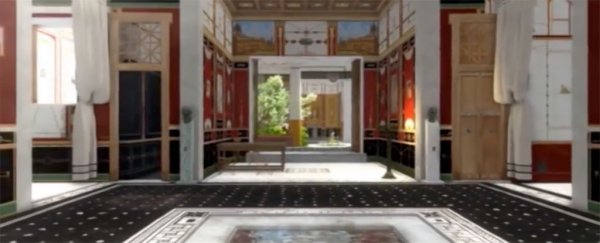Archaeologists have virtually reconstructed an ancient Pompeii house in 3D, revealing the beauty of a well-to-do Italian home almost 2,000 years ago.
The project, which recreates the dwelling of a wealthy Pompeii banker called Caecilius Iucundus, gives us our best look yet at what living conditions were like in the famous city before the devastating eruption of Mount Vesuvius in 79 AD.
The reconstruction builds upon the work of the Swedish Pompeii Project, which began in 2000 at the Swedish Institute in Rome and is now overseen by researchers at Sweden's Lund University.
Scientists led by archaeologist Anne-Marie Leander Touati conducted 3D scanning of a Pompeii city block during fieldwork expeditions between 2011 and 2012, and the plush home you can see in the video below is one of the first 3D models to be completed as part of the virtual restoration:

"By combining new technology with more traditional methods, we can describe Pompeii in greater detail and more accurately than was previously possible," says one of the researchers, digital archaeologist Nicoló Dell´Unto.
The city block the researchers scanned with hand-held laser scanners and a drone is called Insula V1, and was chosen because it was situated at the crossing of two of Pompeii's main thoroughfares.
Because of this centralised location, the researchers say it was a privileged position for both commercial activity and stately living.
This helps to explain some of the grandeur of Caecilius Iucundus's envisaged living space – at least, before the fiery destruction wreaked by Mount Vesuvius, that is, which is estimated to have claimed more than 2,000 lives.
The researchers acknowledge that details of the virtual home come from a variety of sources.
Some of these sources are objective – such as decorations that are still preserved on site – while others are more speculative, based on archaeologists' best interpretations of what the architecture and lifestyle in ancient Pompeii really looked like nearly 2 millennia ago.
In the interests of authenticity, the researchers haven't populated the reconstruction with virtual family members, visitors, and slaves, but they say the large dwelling would have been filled with people both day and night.
While Iucundus wasn't part of the ruling political elite in Pompeii, we know from his surviving correspondence that he was a very wealthy man.
His home was designed to let as much light in as possible to enable him to work, with the house's most decorated room being called the tabularium, where Iucundus would have seen to his affairs.
Insula V1 features two large wealthy estates in addition to the banker's home, plus a tavern, a laundry, a bakery, and several gardens – one of which had taps for a fountain left running at the time of the eruption, the researchers say.
While the primary purpose of the video is to provide the public with a glimpse into the conditions of ancient Pompeii life, the overall aim of the research is more scientific – the team will be sharing their entire 3D data set and workflow, "to make the reconstruction process completely transparent and available for researchers and students".
Awesome – and that means it's possible too that we could be seeing a lot more of ancient Pompeii soon.
You can watch the researchers explain more about the virtual reconstruction project in the video below:

The research is reported in Scires It.
